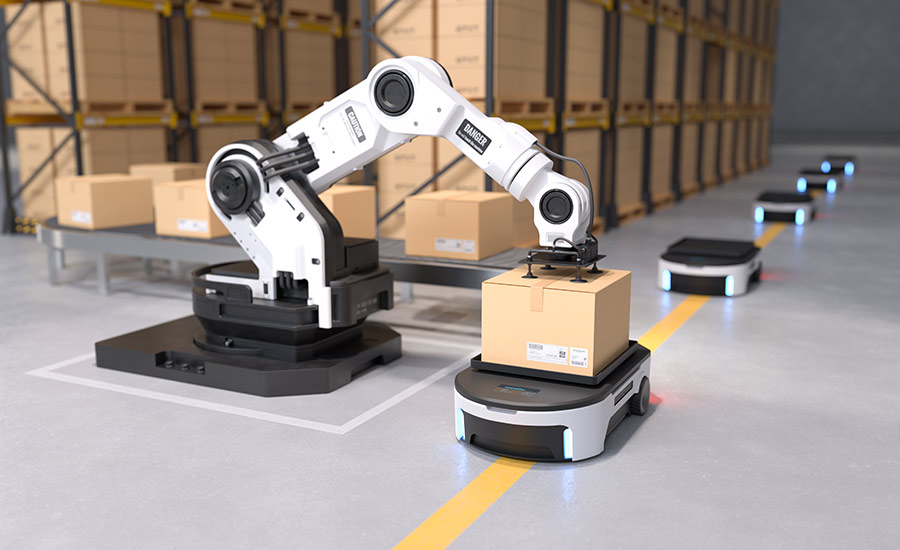The global supply chain is undergoing rapid transformation with the integration of advanced robotics in warehouse management. As e-commerce, retail, and logistics demand faster, more accurate, and cost-effective solutions, robotics is reshaping warehouse operations by automating material handling, inventory tracking, and order fulfillment. Robotics-driven warehouses not only improve efficiency but also enhance safety, scalability, and overall operational resilience.
Types of Robotics Used in Warehouse Automation
1. Autonomous Mobile Robots (AMRs)
- Navigation & Flexibility: Unlike traditional automated guided vehicles (AGVs), AMRs use AI and sensors for real-time navigation without the need for predefined paths.
- Pick-and-Place Operations: Robots like Locus Robotics and Fetch Robotics streamline warehouse picking, reducing human effort.
- Real-Time Adaptation: AMRs adjust routes dynamically based on traffic and workload, improving efficiency.
2. Automated Guided Vehicles (AGVs)
- Fixed Path Transport: AGVs follow magnetic strips or predefined routes for moving goods between warehouse zones.
- Material Handling & Pallet Transport: Commonly used for heavy load transportation, reducing reliance on forklifts.
- Use in Large-Scale Warehouses: AGVs are ideal for high-volume fulfillment centers requiring predictable movement patterns.
3. Robotic Arms for Picking & Sorting
- AI-Powered Precision: Industrial robotic arms, equipped with computer vision and AI, can pick, pack, and sort items at high speeds.
- Bin-Picking Automation: Robots like RightHand Robotics use grippers and suction to handle a variety of objects.
- Error Reduction: Reduces mis-picks and misplacements, ensuring accuracy in order fulfillment.
4. Drone Technology for Inventory Management
- Aerial Scanning & Monitoring: Drones equipped with RFID scanners or barcode readers conduct inventory audits without human intervention.
- Stock Tracking & Reconciliation: Reduces the need for manual cycle counting and increases inventory accuracy.
- Warehouse Surveillance: Drones monitor security and ensure compliance with storage regulations.
5. Automated Storage and Retrieval Systems (AS/RS)
- Vertical & High-Density Storage: Maximizes warehouse space through automated shelving and robotic retrieval.
- Rapid Item Retrieval: Used in fulfillment centers to quickly locate and retrieve products, speeding up order processing.
- Seamless Integration with AMRs & AGVs: Works alongside other robotics systems to optimize supply chain efficiency.
How Robotics is Revolutionizing Warehouse Operations
1. Enhancing Order Fulfillment Speed & Accuracy
- Robotics ensures faster picking and packing, reducing human errors in order processing.
- AI-driven robotics systems predict demand fluctuations and optimize inventory placement for rapid fulfillment.
2. Reducing Labor Costs & Addressing Workforce Shortages
- Robotics minimizes dependency on manual labor, reducing operational costs.
- Automated solutions compensate for the shortage of skilled warehouse workers, ensuring uninterrupted supply chain processes.
3. Improving Workplace Safety
- Robotics eliminates the need for human workers to lift heavy loads or operate in hazardous conditions.
- AI-driven safety protocols reduce collision risks, fatigue-related errors, and workplace accidents.
4. Maximizing Warehouse Space Utilization
- Automated storage and retrieval systems enable vertical stacking, making optimal use of available space.
- Robotics-based inventory management reduces wasted space by ensuring efficient stock organization.
5. Enhancing Scalability & Operational Flexibility
- AI-powered robotics allow warehouses to scale operations based on seasonal demand fluctuations.
- Robotics-driven fulfillment centers can adjust workflows dynamically without requiring additional human resources.
Challenges in Implementing Warehouse Robotics
1. High Initial Investment Costs
- Advanced robotics systems require significant capital investment, making adoption challenging for small businesses.
- Return on investment (ROI) depends on volume, efficiency gains, and operational scale.
2. Integration with Legacy Systems
- Many warehouses rely on outdated warehouse management systems (WMS), making robotic integration complex.
- Upgrading software and infrastructure is crucial for ensuring seamless robotics deployment.
3. Workforce Adaptation & Training
- Employees need training in robotics operations and maintenance to ensure smooth collaboration between humans and machines.
- The transition requires change management strategies to address worker concerns and skill gaps.
4. Cybersecurity Risks in Connected Warehouses
- AI-driven robotics are connected to cloud-based networks, increasing the risk of cyberattacks and data breaches.
- Secure encryption, access controls, and AI-driven threat detection are essential for protecting robotic infrastructure.
- AI-Driven Predictive Analytics: Robots will use machine learning algorithms to predict demand trends, optimize stocking strategies, and improve supply chain forecasting.
- 5G-Enabled Smart Warehouses: High-speed, low-latency 5G networks will enable real-time robotic coordination, enhancing warehouse efficiency.
- Autonomous Swarm Robotics: Future warehouses will deploy multiple synchronized robots working collaboratively for ultra-fast order processing.
- Human-Robot Collaboration (Cobots): The rise of collaborative robots (cobots) will ensure that humans and AI-powered machines work seamlessly together.
With advancements in AI, machine learning, and IoT, robotics is transforming warehouse management into a hyper-efficient, autonomous, and scalable ecosystem.
From Our Editorial Team
Our Editorial team comprises of over 15 highly motivated bunch of individuals, who work tirelessly to get the most sought after curated content for our subscribers.


